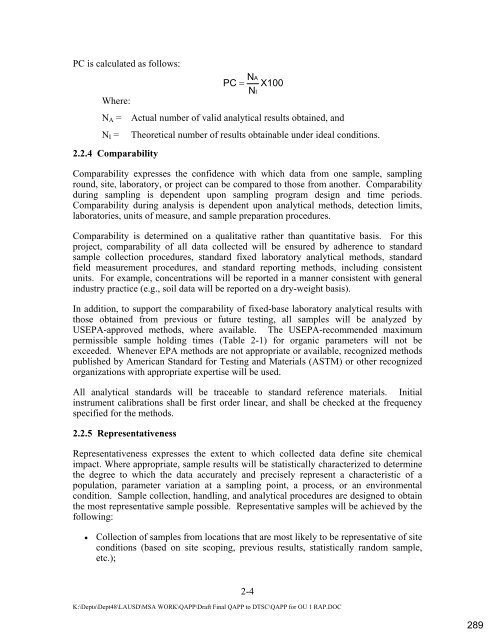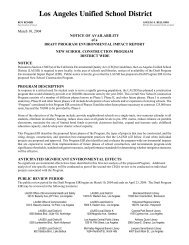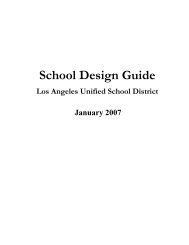Site-Specific Health and Safety Plan (HASP) - Laschools.org
Site-Specific Health and Safety Plan (HASP) - Laschools.org
Site-Specific Health and Safety Plan (HASP) - Laschools.org
Create successful ePaper yourself
Turn your PDF publications into a flip-book with our unique Google optimized e-Paper software.
PC is calculated as follows:<br />
Where:<br />
NA<br />
PC = X100<br />
NI<br />
NA = Actual number of valid analytical results obtained, <strong>and</strong><br />
NI = Theoretical number of results obtainable under ideal conditions.<br />
2.2.4 Comparability<br />
Comparability expresses the confidence with which data from one sample, sampling<br />
round, site, laboratory, or project can be compared to those from another. Comparability<br />
during sampling is dependent upon sampling program design <strong>and</strong> time periods.<br />
Comparability during analysis is dependent upon analytical methods, detection limits,<br />
laboratories, units of measure, <strong>and</strong> sample preparation procedures.<br />
Comparability is determined on a qualitative rather than quantitative basis. For this<br />
project, comparability of all data collected will be ensured by adherence to st<strong>and</strong>ard<br />
sample collection procedures, st<strong>and</strong>ard fixed laboratory analytical methods, st<strong>and</strong>ard<br />
field measurement procedures, <strong>and</strong> st<strong>and</strong>ard reporting methods, including consistent<br />
units. For example, concentrations will be reported in a manner consistent with general<br />
industry practice (e.g., soil data will be reported on a dry-weight basis).<br />
In addition, to support the comparability of fixed-base laboratory analytical results with<br />
those obtained from previous or future testing, all samples will be analyzed by<br />
USEPA-approved methods, where available. The USEPA-recommended maximum<br />
permissible sample holding times (Table 2-1) for <strong>org</strong>anic parameters will not be<br />
exceeded. Whenever EPA methods are not appropriate or available, recognized methods<br />
published by American St<strong>and</strong>ard for Testing <strong>and</strong> Materials (ASTM) or other recognized<br />
<strong>org</strong>anizations with appropriate expertise will be used.<br />
All analytical st<strong>and</strong>ards will be traceable to st<strong>and</strong>ard reference materials. Initial<br />
instrument calibrations shall be first order linear, <strong>and</strong> shall be checked at the frequency<br />
specified for the methods.<br />
2.2.5 Representativeness<br />
Representativeness expresses the extent to which collected data define site chemical<br />
impact. Where appropriate, sample results will be statistically characterized to determine<br />
the degree to which the data accurately <strong>and</strong> precisely represent a characteristic of a<br />
population, parameter variation at a sampling point, a process, or an environmental<br />
condition. Sample collection, h<strong>and</strong>ling, <strong>and</strong> analytical procedures are designed to obtain<br />
the most representative sample possible. Representative samples will be achieved by the<br />
following:<br />
• Collection of samples from locations that are most likely to be representative of site<br />
conditions (based on site scoping, previous results, statistically r<strong>and</strong>om sample,<br />
etc.);<br />
2-4<br />
K:\Depts\Dept48\LAUSD\MSA WORK\QAPP\Draft Final QAPP to DTSC\QAPP for OU 1 RAP.DOC<br />
289







